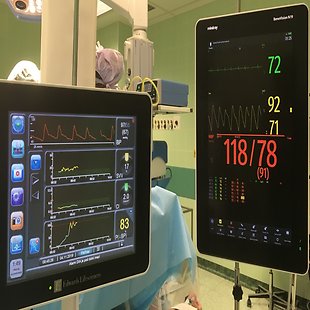Hemodynamic monitoring
Knowledge of hemodynamics is not the only domain of anesthesia. It is an integral part of almost all medical disciplines. In our algorithm, the investigator can try several possibilities of monitoring hemodynamics in anesthetized patient: non-invasive blood pressure measurement, continuous blood pressure measurement by invasive and non-invasive method, but also advanced monitoring by pulse contour analysis. It is necessary to realize that correct evaluation of the patient's physiological functions has a significant effect on his outcome, long-term hypotension increases risk of perioperative perioperative myocardial infarction, stroke and acute kidney injury; in contrast, fluid overload can cause pulmonary edema or heart failure.
Review
Hemodynamic monitoring is one of the basic monitored parameters in patients under general anesthesia. Non-invasive blood pressure monitoring (time interval <5 min.) and continuous ECG recording are considered to be the minimum standard. However, in many cases this level of monitoring is insufficient, especially in fragile patients and/or extensive surgeries where rapid changes in hemodynamics can be expected, eg. large vascular procedures, liver resections, etc. In these cases it makes sense to use continuous blood pressure monitoring, whether non-invasive (good peripheral blood supply is precondition) or invasive. It has been shown that even short episode of hypotension in the order of minutes can have negative effects. In the case of fragile patients and risky procedures, it is appropriate to use one of the minimally invasive hemodynamic monitorings, which provide us not only with information on blood pressure, but also cardiac output and parameters that affect it (preload, afterload, contractility). Such a measurement is the basis of the so-called early goal directed therapy, which has proven its benefit for patients in a number of studies.
Sources
CHAMBERS, David; HUANG, Christopher; MATTHEWS, Gareth. Basic physiology for anaesthetists. Cambridge University Press, 2019. p. 111-163.
MEIDERT, Agnes S.; SAUGEL, Bernd. Techniques for non-invasive monitoring of arterial blood pressure. Frontiers in medicine [online], 2018, 4: 231 [cit. 2020-04-12]. Available at: https://www.frontiersin.org/articles/10.3389/fmed.2017.00231/full
MARIK, Paul E.; MONNET, Xavier; TEBOUL, Jean-Louis. Hemodynamic parameters to guide fluid therapy. Annals of intensive care [online], 2011, 1.1: 1. [cit. 2020-04-12] Available at: https://link.springer.com/article/10.1186/2110-5820-1-1
WESSELINK, E. M., et al. Intraoperative hypotension and the risk of postoperative adverse outcomes: a systematic review. British journal of anaesthesia [online], 2018, 121.4: 706-721. [cit. 2020-04-12] Available at: https://www.sciencedirect.com/science/article/pii/S0007091218303763
MONNET, Xavier; MARIK, Paul; TEBOUL, Jean-Louis. Passive leg raising for predicting fluid responsiveness: a systematic review and meta-analysis. Intensive care medicine [online], 2016, 42.12: 1935-1947. [cit. 2020-04-12] Available at: https://link.springer.com/article/10.1007%2Fs00134-015-4134-1
BENEŠ J. Prediction of fluid responsiveness. Anest. intenziv. Med. [online], 28, 2017, ed. 1, p. 12–22. [cit. 2020-04-12] Available at: https://www.prolekare.cz/casopisy/anesteziologie-intenzivni-medicina/2017-1/predikce-odpovedi-na-podani-tekutiny-tekutinova-reaktivita-60590





